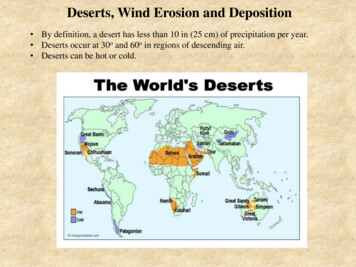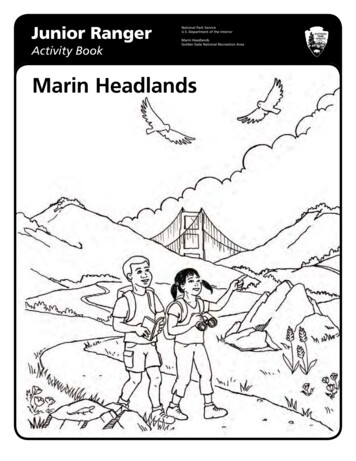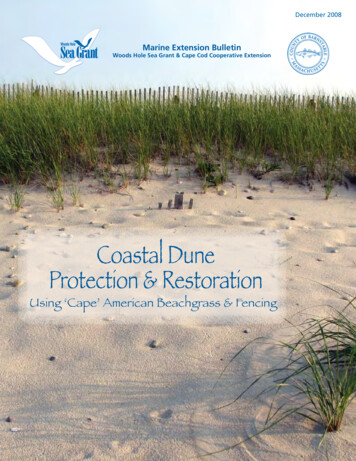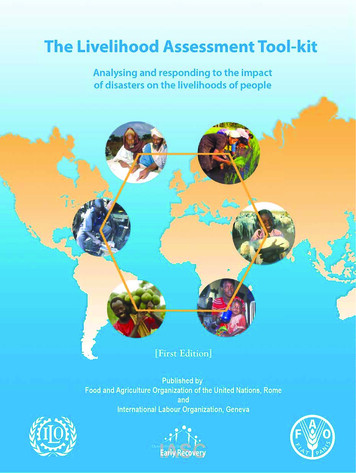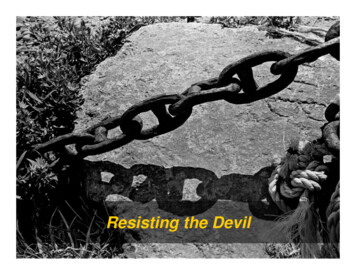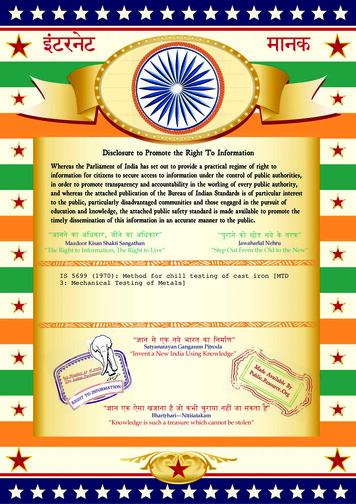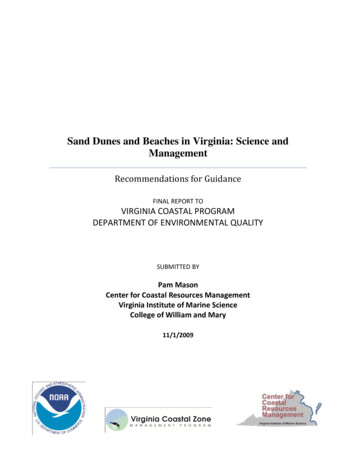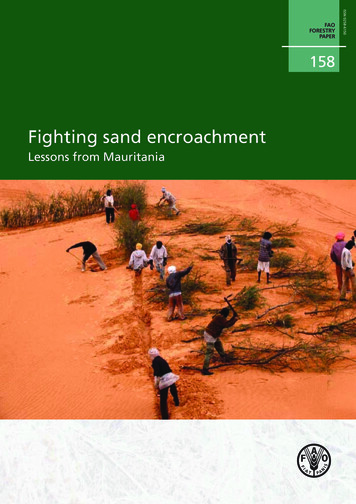
Transcription
158Fighting sand encroachmentLessons from MauritaniaISSN 0258-6150FAOFORESTRYPAPER
Cover photo:Mechanical dune stabilization: installing plant matterM. Ould Mohamed
Fighting sand encroachmentLessons from MauritaniabyCharles Jacques BerteConsultantwith the collaboration ofMoustapha Ould Mohamed and Meimine Ould SaleckNature Conservation DirectorateMinistry of the Environment and Sustainable Development of MauritaniaFOOD AND AGRICULTURE ORGANIZATION OF THE UNITED NATIONSRome, 2010FAOFORESTRYPAPER158
The designations employed and the presentation of material in this information product donot imply the expression of any opinion whatsoever on the part of the Food and AgricultureOrganization of the United Nations (FAO) concerning the legal or development status ofany country, territory, city or area or of its authorities, or concerning the delimitation of itsfrontiers or boundaries. The mention of specific companies or products of manufacturers,whether or not these have been patented, does not imply that these have been endorsed orrecommended by FAO in preference to others of a similar nature that are not mentioned.The views expressed in this information product are those of the author(s) and do notnecessarily reflect the views of FAO.ISBN 978-92-5-106531-0All rights reserved. FAO encourages the reproduction and dissemination of material in thisinformation product. Non-commercial uses will be authorized free of charge, upon request.Reproduction for resale or other commercial purposes, including educational purposes,may incur fees. Applications for permission to reproduce or disseminate FAO copyrightmaterials, and all queries concerning rights and licences, should be addressed by e-mailto copyright@fao.org or to the Chief, Publishing Policy and Support Branch, Office ofKnowledge Exchange, Research and Extension, FAO, Viale delle Terme di Caracalla, 00153Rome, Italy. FAO 2010
iiiContentsForewordA prologue from Prince Laurent of BelgiumAcknowledgementsAbbreviations, acronyms and terminologyvviviiiix1. Introduction12. Understanding sand encroachment3Wind erosion3Origin of sand5Effects of wind erosion5Wind-borne accumulations6Identification of sanded-over sites10Types of treatment113. Sand dune fixation techniques13Primary fixation13Biological fixation154. An experience in sand dune fixation: rehabilitating and extendingthe Nouakchott Green Belt19Preliminary studies20Tree nurseries22Mechanical dune stabilization26Biological dune fixation28Protection of reforested areas30Main constraints315. Participatory approach33In urban and periurban areas34In rural areas356. Management and harvesting of plantations377. Institutional aspects39Government support39Administrative supervision and project management39Bibliography43Annex 1. Some woody and grassy species used in sand dune fixation45Annex 2. Administrative supervision and project management charts57
ivFigures1Wind speed in function of altitude32Ways in which particles are carried by the wind43Nebkas64Barchans75Linear dunes86Sand ridges87Pyramidal dune98Aklé dune99Dynamics of sand encroachment1010 Stop or check dune1311 Deflection or diversion dune1312 Air flow above a permeable screen (A) and an impermeable screen (B)1513 The Toujounine intervention zone20
vForewordMauritania is one of the Sahelian countries most severely affected by the repeated periodsof drought that have been occurring since the end of the 1960s. Desertification controlhas always been a national priority and a central concern of successive governments,taking the practical form of various development plans and programmes over the pastfour decades.After ratification of the United Nations Convention to Combat Desertification(UNCCD), in June 2001 Mauritania formulated a National Action Plan to CombatDesertification (PAN-LCD), adopting an integrated, participatory approach. As inother countries in the Sahelian region, constantly increasing desertification is due tovarious natural, human, juridical and socio-economic factors, which combine to causedegradation of soil, forest resources and biodiversity.Implementation of the PAN-LCD is based on various fundamental principals,including:r BEPQUJPO PG BO JOUFHSBUFE BQQSPBDI DPWFSJOH QIZTJDBM CJPMPHJDBM JOTUJUVUJPOBM BOE socio-economic aspects;r JOUFHSBUJPO PG QPWFSUZ SFEVDUJPO JOUP EFTFSUJGJDBUJPO DPOUSPM QSPHSBNNFTr DPPSEJOBUJPO PG BDUJWJUJFT UP CF DBSSJFE PVU VOEFS UIF 1"/ - % XJUI UIPTF PG other United Nations framework conventions, such as the Convention on ClimateChange and the Convention on Biological Diversity;r NPSF DMPTFMZ UBSHFUFE JOUFSOBUJPOBM BTTJTUBODF JO PSEFS UP SFTQPOE CFUUFS UP MPDBM needs in the framework of partnership agreements;r UIF QBSUJDJQBUPSZ BQQSPBDI XJUI DMPTF DPMMBCPSBUJPO PG HSBTTSPPUT DPNNVOJUJFT especially local government and non-governmental organizations;r FODPVSBHFNFOU PG TDJFOUJGJD SFTFBSDI BOE UIF VTF PG JUT SFTVMUT JO UIF SFIBCJMJUBUJPO of degraded land and the improvement of agrosilvopastoral production.The present publication has been produced within the framework of FAO supportfor the Mauritanian Government’s efforts to combat desertification, and reflects resultsand lessons learned during implementation of the Support for the Rehabilitation andExtension of the Nouakchott Green Belt Project with financing from the WalloonRegion and the support of Prince Laurent of Belgium.J.A. PradoDirector, Forest Assessment, Management and Conservation DivisionFAO Forestry Department
viA prologue from Prince Laurentof BelgiumWhat picture can we give our children today of our relationships between north andsouth, which are so often tarnished by a spirit of imperialism and a poor knowledge andunderstanding of other cultures that too often are foreign to us? The spectacular progressof science and knowledge in recent decades should have allowed us to know each otherbetter, thus enabling us to join together to envisage a more sustainable outlook for thefuture. The foundations of our western civilization and knowledge come from othercontinents, including of course Africa.Today, we sometimes have to realize that when we withdraw into ourselves this givesrise to relationships based on force and thus to immense frustration. However, if we takethe time to reflect on nature, it teaches us that the party we believe to be the strongest isnot always the one that wins out over the weakest.I was deeply imbued with the knowledge, love and passion for forests of my spiritualfather, Raymond Antoine, Professor Emeritus of Forest Engineering at the CatholicUniversity of Louvain, who is always present in my thoughts. I also love to strollthrough the works of my friend Jean-Marie Pelt, Professor Emeritus of Plant Biologyand Pharmacology at the University of Metz, for whom I have great admiration.Professor Pelt is particularly interested in the relationships of attraction and repulsionamong plants and animals in a single ecosystem. Based on his observations, he teachesus about the relations between the Douglas fir and the birch. These two trees exchangecarbonaceous sugars through almost invisible mycelial filaments. As the Douglas fir hasneedle-shaped leaves throughout the year, which ensure its photosynthetic activity, it isable to pass on carbonaceous sugars to a leafless fellow tree of another species. During itsvegetative period, the birch provides the same service to the Douglas fir. What a splendidsymbiosis we see in the plant world with the fragile-looking fungus, which brings thetree the water and mineral salts it needs, and the tree, which in return offers the organicnutrients the fungus needs for its survival. And of course there is the orchid specieswith no chlorophyll whose development and survival is vitally linked to the beech treethrough similar mycelia.All this shows us how much more attention we should pay to ecology and theenvironment. I am convinced that many of our societies’ problems could find solutionsin the mechanisms underpinning nature.The relationship between trees, development and the maintenance of a sustainableagriculture is not yet sufficiently well established in our consciousness. It has been shown inEurope that forest and agricultural monocropping systems produce much less timber andfood than does a harmonious combination of these two elements, as found in agroforestry.It is still too little known that trees generate soil and thus allow the development ofsustainable agriculture, and also that they prevent erosion and conserve water.However, in the greater Maghreb region, where pastoralism is the predominantsystem, silviculture provides the guarantee of sustainable agriculture. If we are toattain this ambitious objective, we have to establish an agrosilvopastoral centre withinthe region to facilitate scientific exchanges between north and south and among thecountries of the region.This undeniably leads us to realize that the very concept of the environment is thesource of a better understanding of our various cultures, and will hence generate peace.Without a doubt, the two main challenges facing our planet will be, on the one hand,the development of renewable energies that are accessible to one and all and, on theother, the reforestation of forest land.
viiI was delighted that the project I had presented to His Excellency Maaouiya OuldSid’Agmed Taya, then President of Mauritania, was given major priority both by himand his country, and that he entrusted me with seeing it through to completion.The present President, His Excellency Mohamed Ould Abdel Aziz, has assured me ofhis support and complete collaboration in maintaining the work carried out.I would thank the partners who have enabled me to achieve my objectives: FAOand the Walloon Region of Belgium, together with the Mauritanian Ministry of theEnvironment and Sustainable Development.His Royal Highness,Prince Laurent of Belgium
viiiAcknowledgementsThe author is keen to thank a whole series of people without whom the Support forthe Rehabilitation and Extension of the Nouakchott Green Belt Project and the presentdocument would have been impossible:r 1SJODF -BVSFOU PG #FMHJVN 1SFTJEFOU PG UIF 3PZBM *OTUJUVUF GPS 4VTUBJOBCMF /BUVSBM Resource Management and the Promotion of Clean Technology, who must becredited with the initiative for this project, and his adviser, James Lohest;r UIF NJOJTUFST PG UIF 8BMMPPO 3FHJPO PG #FMHJVN JO PGGJDF EVSJOH UIF DPVSTF PG UIF project: Marie-Dominique Simonet, William Ancion, Michel Forêt, José Happart,Benoît and Guy Lutgen, Jean-Claude Van Cauwenberg and Rudy Demotte;r UIF .JOJTUSZ PG UIF &OWJSPONFOU BOE 4VTUBJOBCMF %FWFMPQNFOU PG .BVSJUBOJB BOE its Directorate for Nature Protection for their constant support for the project;r 1IJMJQQF 4VJOFO (FOFSBM "ENJOJTUSBUPS PG 8BMMPOJF #SVYFMMFT *OUFSOBUJPOBMmMultilatéral Mondial (WBI), together with Philippe Cantraine and Daniel Sotiaux,WBI Directors, and Laurence Degoudenne, WBI Desk Chief;r UIF 0QFSBUJPOBM (FOFSBM %JSFDUPSBUF GPS "HSJDVMUVSF /BUVSBM 3FTPVSDFT BOE UIF Environment, Department of Nature and Forests, especially Philippe Blerot,Inspector General, and Guy Coster, Officer;r UIF 4FSWJDF IJFGT PG UIF 'PSFTU POTFSWBUJPO 4FSWJDF PG UIF 'PSFTU "TTFTTNFOU Management and Conservation Division of FAO in Rome, especially El HadjiSene;r UIF '"0 SFQSFTFOUBUJWFT JO .BVSJUBOJB QBSUJDVMBSMZ /PVSSFEJOF ,BESB BOE 3BEJTMBW Pavlovic, for their assistance and advice, and for the facilities provided throughoutthe project; also all the administrative staff of this office;r "OESÊ .BUUPO PG UIF '"0 -JBJTPO 0GGJDF JO #SVTTFMT GPS UIF &VSPQFBO 6OJPO BOE Belgium;r UIF 8PSME 'PPE 1SPHSBNNF 8'1 SFQSFTFOUBUJWFT JO .BVSJUBOJB BOE UIF 8'1 0GGJDFS JO IBSHF PG UIF &OWJSPONFOU 1SPHSBNNF #PVCBDBS ,POUÊr 3BZNPOE "OUPJOF BEWJTFS UP UIF 8BMMPPO 3FHJPO XIP DPOUSJCVUFE DPOTJEFSBCMZ to the success of the project with his professional experience and many elements ofadvice offered during technical and evaluation missions;r POBUIBO 4IBEJE %JSFDUPS PG UIF OBUJPOBM OPO HPWFSONFOUBM PSHBOJ[BUJPO Communication in the Service of Development (NEDWA) in Mauritania.The author expresses special gratitude to Moustapha Ould Mohamed and MeimineOuld Saleck, Water and Forestry Engineers at the Nature Conservation Directorate,who are respectively National Coordinator and Coordinator of Works for the Supportfor the Rehabilitation and Extension of the Nouakchott Green Belt Project, and also toall technical and field staff.
ixAbbreviations, acronymsand US WBIWFPwilayaArab Fund for Economic and Social DevelopmentPermanent Inter-State Committee for Drought Control in the SahelDanish International Development AgencyFood and Agriculture Organization of the United NationsGerman Agency for Technical CooperationInternational Fund for Agricultural DevelopmentLutheran World Federationprefecturenon-governmental organizationNational Action Plan for the EnvironmentNational Action Plan to Combat Desertification, MauritaniaDesertification Control Master PlanSand Encroachment Control and Agrosilvopastoral Development ProjectMultisectoral Desertification Control Programmeouguiya (Mauritanian currency)United Nations Convention to Combat DesertificationUnited Nations Development ProgrammeUnited Nations Environment ProgrammeUnited Nations Sudano-Sahelian OfficeUnited States dollarWallonie-Bruxelles InternationalWorld Food Programmeadministrative district
11. IntroductionThe United Nations Convention to Combat Desertification (UNCCD), adopted inParis on 17 June 1994, includes the following definitions:r iEFTFSUJGJDBUJPOu NFBOT MBOE EFHSBEBUJPO JO BSJE TFNJ BSJE BOE ESZ TVCIVNJE areas resulting from various factors, including climatic variations and humanactivities;r iDPNCBUJOH EFTFSUJGJDBUJPOu JODMVEFT BDUJWJUJFT XIJDI BSF QBSU PG UIF JOUFHSBUFE development of land in arid, semi-arid and dry subhumid areas for sustainabledevelopment which are aimed at:- prevention and/or reduction of land degradation;- rehabilitation of partly degraded land;- reclamation of desertified land.Mauritania is one of the Sahelian countries most severely affected by the periodsof drought that have been occurring since 1968. The resulting desertification isexacerbated by human activities, which have compounded climatic factors, with directDPOTFRVFODFT GPS BO BMSFBEZ QSFDBSJPVT TJUVBUJPO m CSJOHJOH BCPVU EFHSBEBUJPO PG the environment and the general socio-economic conditions of the country, and theprogressive impoverishment of a population that is 70 percent rural.The main effect of desertification has been a reduction in the amount of arable land,grazing land, forests and water resources. Various studies show that mobile sand dunestoday cover two-thirds of the country’s land area.The devastating effects of desertification and drought on agricultural productivityand yields have resulted in:r FOEBOHFSNFOU PG SVSBM JOIBCJUBOUT GPPE TFDVSJUZ BOE TUBOEBSE PG MJWJOHr MBSHF TDBMF NPWFNFOUT PG QFPQMF UPXBSE NBKPS VSCBO DFOUSFTJ. SHADIDJ. SHADIDSand encroachment threatening the town of Nouakchott
2Fighting sand encroachment: lessons from Mauritaniar SFEVDFE XBUFS TVQQMJFT GPS IVNBO BOE MJWFTUPDL OFFETr TVCTUBOUJBM FDPOPNJD MPTTFT In view of the extent of the phenomenon, Mauritania, like many other countriesaffected by drought and desertification, has expressed a firm political will to combatthis scourge.It was in this context that the Sahel Club and the Permanent Inter-State Committeefor Drought Control in the Sahel (CILSS) were established. In 1980, CILSS designeda drought control and development strategy for the countries of the Sahel, withthe two main objectives of bringing about food self-sufficiency and environmentalbalance. However, implementation of the strategy did not have the anticipated resultsbecause of the complexity of the desertification problem. Recognizing this failure, theMauritanian Government decided to incorporate desertification control into an overallprocess of sustainable development of the country, encompassing technical, socioeconomic, juridical and institutional factors, a decision leading to:r GPSNVMBUJPO PG B %FTFSUJGJDBUJPO POUSPM .BTUFS 1MBO 1%- %r GPSNVMBUJPO PG B .VMUJTFDUPSBM %FTFSUJGJDBUJPO POUSPM 1SPHSBNNF 1.- %r GPSNVMBUJPO PG B /BUJPOBM "DUJPO 1MBO UP PNCBU %FTFSUJGJDBUJPO 1"/ - %r GPSNVMBUJPO PG B /BUJPOBM "DUJPO 1MBO GPS UIF &OWJSPONFOU 1"/& Within this framework, national-level programmes and projects have beenimplemented with the support of development partners in order to foster conservationand agrosilvopastoral development and combat sand encroachment. These programmesand projects include:r UIF /PVBLDIPUU (SFFO #FMU 1SPKFDU GJOBODFE CZ UIF -VUIFSBO 8PSME 'FEFSBUJPO (LWF);r UIF 4BOE %VOF 4UBCJMJ[BUJPO BOE 'JYBUJPO 1SPKFDU GJOBODFE CZ UIF 6OJUFE /BUJPOT Development Programme (UNDP), the Danish International DevelopmentAgency (DANIDA) and the United Nations Sudano-Sahelian Office (UNSO);r UIF 4BOE &ODSPBDINFOU POUSPM BOE "HSPTJMWPQBTUPSBM %FWFMPQNFOU 1SPKFDU (PLEMVASP), also financed by UNDP, DANIDA and UNSO;r UIF 0BTJT %FWFMPQNFOU 1SPKFDU GJOBODFE CZ UIF *OUFSOBUJPOBM 'VOE GPS "HSJDVMUVSBM Development (IFAD) and the Arab Fund for Economic and Social Development(AFESD);r UIF ,BFEJ (SFFO #FMU 1SPKFDU GJOBODFE CZ UIF &VSPQFBO 6OJPOr UIF *OUFHSBUFE /BUVSBM 3FTPVSDF .BOBHFNFOU JO &BTU .BVSJUBOJB 1SPKFDU GJOBODFE by the German Agency for Technical Cooperation (GTZ);r UIF 4VQQPSU GPS UIF 3FIBCJMJUBUJPO BOE &YUFOTJPO PG UIF /PVBLDIPUU (SFFO #FMU Project, with financing from the Walloon Region of Belgium and the support ofPrince Laurent of Belgium.
32. Understanding sandencroachmentSand encroachment is said to take place when grains of sand are carried by winds andcollect on the coast, along water courses and on cultivated or uncultivated land.As the accumulations of sand (dunes) move, they bury villages, roads, oases, crops,market gardens, irrigation channels and dams, thus causing major material and socioeconomic damage. Desertification control programmes must then be implemented inorder to counter this very serious situation.Before designing such programmes, information is needed about the factors andprocesses fostering the formation and movement of sand masses, i.e. wind and soil.WIND EROSIONThe main causes of wind erosion are:r B WJPMFOU XJOE CMPXJOH PWFS MBSHF BSFBTr TUVOUFE PS TQBSTF WFHFUBUJPOr B EFHSBEFE TPJM UIBU JT NPCJMF CBSF BOE ESZ Violence of windThe first factor affecting the displacement of soil particles is the direction, speed andduration of the wind. When a wind blows predominantly from one direction, it is known asa prevailing wind. Wind speed is zero at ground level, but increases in force the higher it isfrom the surface of the ground, its speed increasing as the logarithm of height (Figure 1).A wind cannot lift sand particles off the ground until its speed at 30 cm aboveground level, measured with an anemometer, is at least 6 m per second. Wind speed isan essential factor, for it determines the force of sand removal. The greater is the speed,the greater the carrying capacity.The second factor is the size and density of sand particles. Particles with a diameterof about 0.1 mm are the first to be removed, whereas a violent wind is needed toremove larger particles.FIGURE 1Wind speed in function of altitudeHeightWind speedCurve S f(h), according to HeninSource: Henin et al., 1960
Fighting sand encroachment: lessons from Mauritania4The nature of the movement of particles varies depending on their size (Figure 2):r 5IF MBSHFTU QBSUJDMFT SPMM PS TMJEF BMPOH UIF HSPVOE JO B NFDIBOJTN LOPXO BT reptation or creep. The grains of sand that move in this way are between 0.5 and2 mm in diameter depending on their density and the wind speed. When they startto travel more slowly because of the braking effect of the sand mass, the saltationmechanism becomes possible.r .FEJVN TJ[FE UP NN EJBNFUFS QBSUJDMFT NPWF GPSXBSE JO TVDDFTTJWF bounds, in a mechanism known as saltation. After leaping into the air, theseparticles fall back to the ground under the effect of weight; 90 percent of themreach a height of no more than 30 cm, moving on average between 0.5 and 1 malong the ground. The saltation mechanism is of vital importance in triggeringwind erosion.r 7FSZ GJOF QBSUJDMFT XJUI B EJBNFUFS PG NJDSPOT PS MFTT BSF TIPU JOUP UIF BJS JO UIF form of dust by the impact of larger grains. These particles then remain suspendedand may be carried a long way in the form of a dust cloud, which often reaches analtitude of 3 000 to 4 000 m.General mechanisms involvedParticles in movement are the site of various interactions, the main ones being theavalanche effect, sorting and corrosion.The avalanche effect is the result of saltation. As the grains of sand fall back, theycause the displacement of a larger quantity of particles, so that the more intense thesaltation process caused by the wind, the greater the number of particles set in motion,until a maximum or saturation point is reached, where the quantity lost is equal to thequantity gained at any given moment. The distance needed to reach this saturationpoint will depend on the sensitivity of a soil to erosion: on a very fragile soil, it canoccur over a distance of about 50 m, whereas it will require more than 1 000 m on areally cohesive soil.The sorting mechanism concerns the wind’s displacement of the finest and lightestparticles, leaving behind the larger particles. This process gradually impoverishesthe soil, since the organic matter made up of small light elements is the first to beremoved.Corrosion is the mechanical attack on the surface as the sand-laden wind blowsover it. In arid regions, it is the aggravating cause of soil erosion and is seen in parallelstreaks or the polishing of rocks.FIGURE 2Ways in which particles are carried by the windSuspensionSaltationReptationSand: large grainsSource: Lemoine, 1996Fine and medium grainsDust
Understanding sand encroachmentState of vegetationVegetation preserves the cohesion of the surface layer of soil, retains particles, resiststhe avalanche effect and is the best protection against the negative effects of wind.This is why wind erosion is such a threat in arid and semi-arid regions where naturalvegetation (whether woodland, bushland or grassland) is sparse, stunted or nonexistent and where rainfall is low and irregular.Moreover, unsustainable harvesting of such slow-growing stands leads to rapiddegradation of the soil, which lacks protection and is therefore subject to the action ofthe wind.Nature and state of soilWind erosion is the result of the wind’s attacking the soil. Such erosion takes place ifthe soil has the following characteristics:r NPCJMF ESZ BOE GJOFMZ DSVTIFE DPBSTF UFYUVSFE SJDI JO GJOF TBOE QPPS JO DMBZ BOE organic matter);r B VOJGPSN TVSGBDF XJUI OP OBUVSBM PS BSUJGJDJBM PCTUBDMFTr TQBSTF PS OPO FYJTUFOU QMBOU DPWFSr DPWFSJOH B TVGGJDJFOUMZ MBSHF BSFB MZJOH JO UIF EJSFDUJPO PG UIF XJOE Soil that has been dried out over a long period is found especially in arid and semiarid zones.The soil’s susceptibility to erosion can be exacerbated by poor farming practices(clearing of large areas), poor pastoral practices (overgrazing, with loosening andpowdering of the soil) and unsustainable harvesting of forests, all of which make itextremely vulnerable to the action of the wind.In Mauritania, soil is generally deep, fragile and predominantly sandy, and is for themost part located in zones with an annual rainfall of less than 100 mm.ORIGIN OF SANDWhen sand is carried by sea currents and accumulates along the shoreline in substantialquantities, it forms coastal dunes.If it comes from the hinterland, it forms inland dunes, in which case the sand iseither non-indigenous, coming from a considerable distance and having particleswith a diameter of less than 0.05 mm, or indigenous, being of local origin and comingfrom the decomposition of mountain rocks (sandstone), the disaggregation of alluvialsoil following the disappearance of plant cover, or from silt carried down by wadisfollowing water erosion of their catchment basins.For a long time, sand encroachment in Mauritania was considered a consequence ofNBUFSJBM DBSSJFE GSPN CPUI OFBS BOE GBS )PXFWFS BDDPSEJOH UP 3BVOFU BOE ,IBUUFMJ (1989), non-indigenous material is insignificant compared with indigenous material.EFFECTS OF WIND EROSIONOn soil5IF XJOE GJSTU DBSSJFT PGG UIF GJOFS QBSUT PG UIF TPJM m BMMVWJVN GJOF TBOE BOE PSHBOJD NBUUFS m UIVT XFBLFOJOH UIF TPJM TUSVDUVSF "T UIF TPJM CFDPNFT TBOEJFS JU JT NPSF vulnerable to the wind and has a reduced water retention capacity. Its colour turnsfrom grey to white and then to red as it is scoured. The terrain is gradually broken upby the creation of small mounds surrounding the woody and grassy vegetation as thisdegrades. The land gradually becomes unsuitable for cultivation.On vegetationThe wind has both mechanical and physiological efforts on vegetation.r Mechanical effects. The soil particles that are carried off collide with stalks andleaves with a force that abrades their tissue. In the zones from which the particles5
Fighting sand encroachment: lessons from Mauritania6are carried off, roots are uncovered and the vegetation risks being uprooted, whilein zones where the particles are deposited the vegetation is steadily buried.r Physiological effects. The wind increases evaporation and dries out plants, mainlyin the dry season. The air’s evaporating power is proportional to the square root ofthe wind speed. Moreover, the soil’s water retention capacity is reduced, leading towater stress. The surrounding or moving mass of dry air tends to absorb humidityBOE FYBDFSCBUF UIF XBUFS EFGJDJU m BOE UIJT EFGJDJU JT UIF NBJO GBDUPS EFUFSNJOJOH MPDBM vegetation, inasmuch as the latter has to adapt to the severe shortage of water.WIND-BORNE ACCUMULATIONSWhen the wind grows lighter, it loses its capacity to carry sand particles, which arethen dropped. Forms of sandy accumulation vary widely, depending on landform, thenature of the soil on which they encroach, the presence or lack of vegetation, and thesize of the grains of sand.The main forms of accumulation found in Mauritania are wind veils, nebkas,barchans, linear dunes, sand ridges, pyramidal dunes, aklés and ergs.Wind veilsSand particles are carried over hard, flat, uniform surfaces, forming sandy veils ofvarying thicknesses, which are a constant threat to villages, roads, railways andirrigation channels. This type of wind accumulation is the source of the surface sandencroachment found almost everywhere in the country, which becomes particularlyserious following clearing, forest fires and overgrazing.Nebka dunesThese accumulations are caused by the presence of a rock, plant or other obstacle in thepath of sand particles in movement. There are two types of nebka: sand arrow nebkas,which are small ovoid dunes (50 cm in height, 150 cm in length and 40 cm in breadth)lying in the direction of the prevailing wind; and bushy nebkas, similar to sand arrownebkas, but capable of reaching a height of 2 m and a length of 3 to 4 m (Figure 3).BarchansThese are huge crescent-shaped dunes convex to the wind (Figure 4). There are severalstages in their formation: they start as sandy shields, then turn into barchanic shields,then barchanic dihedrons, and finally full-scale barchans. Barchans tend not to remainisolated, but can join up and form complexes ranging from train-like successions ofbarchans to real dune massifs.FIGURE 3NebkasWind2m0.5 mSand arrow nebkaSource: FAO, 1988Bushy nebka
Understanding sand encroachment7FIGURE 4BarchansCrestWingConcave leewardslopeBodyConvex windwardslopeWindFrontWingSource: Rochette, 1989J. SHADIDIsolated barchansJ. SHADIDBarchanic field or collection of barchans
Fighting sand encroachment: lessons from Mauritania8Three conditions are needed for barchans to move: a constant wind from onedirection, a large source of sand with grains of 0.12 to 0.25 mm in diameter, and a hard,flat surface. Inasmuch as barchans are unstable, mobile constructions that are constantlybeing remodelled by the wind, they can move several dozen metres per year.Linear or sif dunesLinear dunes are elongated accumulations of sand, drawn out lengthwise like swords (sif in"SBCJD 'JHVSF 5IFZ BSF BMXBZT FJHIU UP UFO UJNFT MPOHFS UIBO UIFZ BSF XJEF m PO BWFSBHF 1 to 2 km long and 50 to 200 m wide. They sometimes gather together in formations thatcan reach 20 to 40 km in length, like those found alongside the Road of Hope.This type of wind accumulation occurs in an arid environment with prevailing windsfrom two directions (northeast and southwest, for example) or a single prevailing windwith air flows that have been split up by irregularities in the terrain. These dunes lieobliquely to the average direction of the prevailing winds. The movement of a lineardune takes place through lengthening as new wind-borne sand is added.Sand ridgesThese ridges are large, broad sandy mounds, running lengthwise, side by side andseparated by deflation corridors (Figure 6). They are fairly stable and do not movemuch. They lie in the direction of the prevailing winds, unlike linear dunes, which areFIGURE 5Linear dunesWindSource: FAO, 1988FIGURE 6Sand ridgesSand ridgesCorridors between dunesSource: FAO, 1988Wind
Understanding sand encroachment9oblique to the average annual direction. Destabilization of these ridges is linked to thedisappearance of woody and grassy cover. This type of formation can be seen on eitherside of the Road of Hope, with ridges running from northeast to southwest.Pyramidal or ghourd dunesPyramidal dunes are hills of sand, often star-s
3. Sand dune fixation techniques 13 Primary fixation 13 Biological fixation 15 4. An experience in sand dune fixation: rehabilitating and extending the Nouakchott Green Belt 19 Preliminary studies 20 Tree nurseries 22 Mechanical dune stabilization 26 Biological dune fixation 28 Protection of reforested areas 30 Main constraints 31 5.
